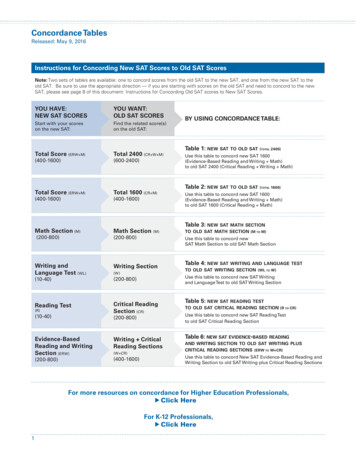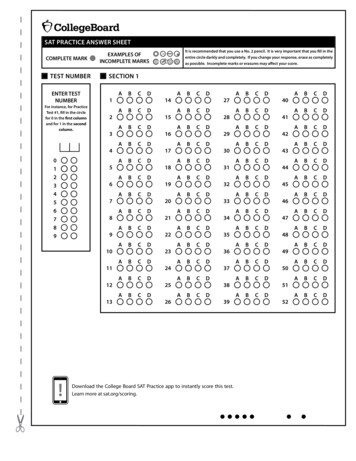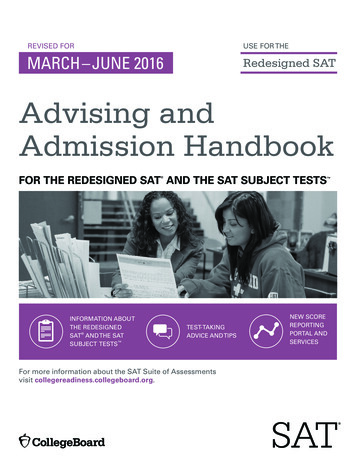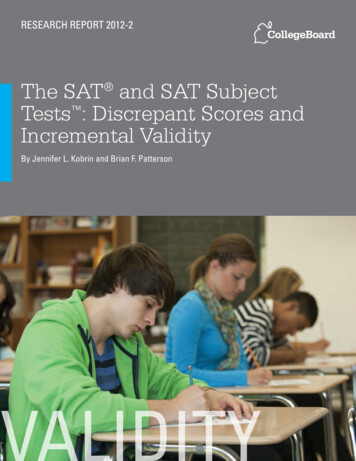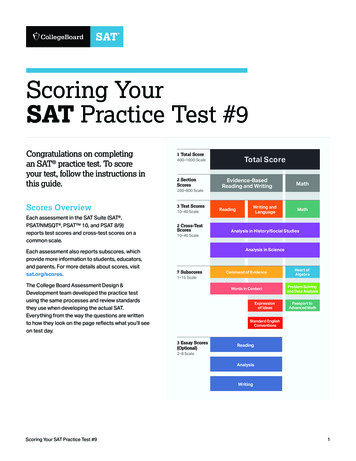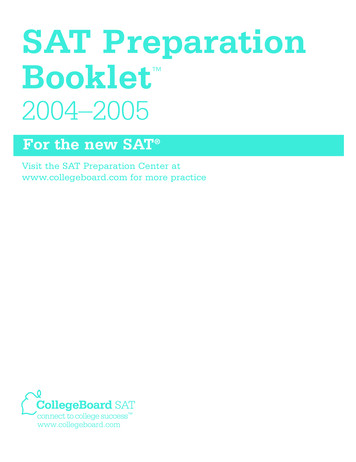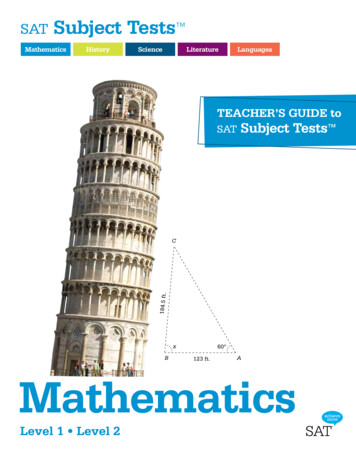
Transcription
SATSubject Tests R’S GUIDE toSATSubject Tests 184.5 ft.CxB60 123 ft.AMathematicsLevel 1 Level 2
MathDear Educator,We know connecting your students with college opportunity and success is important toyou. One way to help your students along the path to higher education is to share withthem the benefits of taking SAT Subject Tests .The SAT Subject Tests are hour-long tests based on high school course work offered acrossfive subject areas: Mathematics, Science, English, History and Languages.Coupled with students’ high school grades and SAT scores, Subject Test scores can createa powerful and comprehensive picture of your students’ capabilities, helping them standout to prospective colleges. Colleges also use SAT Subject Tests to put other admissionfactors into context, place students in certain courses, and even offer credit based onSubject Test performance.To better support you in helping your students do well on these tests, we are pleased toprovide you with the Teacher’s Guide to SAT Subject Tests in Mathematics, a comprehensiveresource that will familiarize you with the mathematics tests and the topics they cover. Italso includes sample questions as well as tips and best practices from other teachers to helpyou prepare your students to do their best on the SAT Subject Tests.The best news for math teachers? SAT Subject Tests cover the material you already teachyour students and strongly align with the Common Core State Standards. In fact, nearly 90percent of the items on the Math I and Math II Subject Tests aligned with one or more ofthe Common Core standards in Math. Eighty percent of high school math teachers agreethat the knowledge and skills measured by the SAT Subject Tests in Mathematics are partof their existing curriculum. Almost 90 percent of mathematics and English high schoolteachers and college professors indicated that the knowledge and skills tested on the SATSubject Tests are important for college readiness.There is no better source than you — teachers in the classroom — when it comes to helpingstudents prepare for the SAT Subject Tests. If you have feedback, tips or ideas you’d like toshare with other teachers, please send them to us at SATSubjectTests@collegeboard.org sowe can include them in future guides.The SAT Subject Tests in Mathematics help your students shine in the college admissionprocess. We appreciate the opportunity to partner with you to help your students showcasethe knowledge and skills you have taught them.The College Board
TABLE OF CONTENTSIntroductionSAT Subject Tests. . . . . . . . . . . . . . . . . . . . . . . . . . . . . . . . . . . . . . . . . . . . . . . . . . . . . . . . . . . . . . . . 2Overview of the Mathematics Subject Tests. . . . . . . . . . . . . . . . . . . . . . . . . . . . . . . . . . . . . . . . . . . . . 9Calculator Use and Geometric Figures. . . . . . . . . . . . . . . . . . . . . . . . . . . . . . . . . . . . . . . . . . . . . . . . 12Mathematics Level 1Sample Questions and Answer Explanations. . . . . . . . . . . . . . . . . . . . . . . . . . . . . . . . . . . . . . . . . . . . 15Mathematics Level 2Sample Questions and Answer Explanations. . . . . . . . . . . . . . . . . . . . . . . . . . . . . . . . . . . . . . . . . . . . 41Best PracticesFrom Teachers to Teachers. . . . . . . . . . . . . . . . . . . . . . . . . . . . . . . . . . . . . . . . . . . . . . . . . . . . . . . . . 65Answer SheetSample SAT Subject Test Answer Sheets. . . . . . . . . . . . . . . . . . . . . . . . . . . . . . . . . . . . . . . . . . . . . . . 69SATSubject Tests1
What Are the SAT Subject Tests ?SAT Subject Tests are one-hour-long exams that give students the opportunity to enhance their collegeadmission credentials by demonstrating their knowledge of specific subjects.They are the only national admission tests where your students choose to take the tests that best showcase theirachievements and interests.Because every student is unique, a student’s academic record often doesn’t tell the whole story of a student’scapabilities and potential. Encourage your students to consider taking one or more SAT Subject Tests so they canshow colleges a more complete picture of their academic background, interests and talents.What Are the Benefits of Taking the SAT Subject Testsin Mathematics?The SAT Subject Tests in Mathematics can help students differentiate themselves in a competitive collegeadmission environment by providing additional information about their readiness for college-level study. This isimportant for all students as it contextualizes other academic credentials, such as grades, SAT scores, etc.Some schools require an SAT Subject Test in Science for admission into science and engineering programsor majors, while others require the tests from all students. For example, the California Institute of Technologyrequires all applicants to submit Subject Test scores in both mathematics and science. Many colleges use SubjectTests to advise students or help with course placement. Other schools allow students to place out of introductorycourses or gain credit based on their performance on certain Subject Tests. Students can visitbigfuture.collegeboard.org/college-search to explore colleges and get information about Subject Testrequirements.TipStudents can use SAT Subject Tests for purposes beyond college admissionand placement. For example, students in New York can use them as asubstitute for some Regents exams for a New York State Regents high schooldiploma. Subject Tests can also be used to fulfill subject-based competencyrequirements for large university systems like the University of Californiaand the University of Arizona.What Are the Differences Between the SAT and the SAT Subject Tests?The SAT is the most widely used college entrance exam, testing what students learn in classrooms and how wellthey apply that knowledge. Its reading, math and writing sections are based on the critical thinking and problemsolving skills needed for college success.SAT Subject Tests cover a wide range of subject areas, including science, history and languages. Each SAT SubjectTest focuses on a single subject and indicates a student’s readiness to take college-level courses in that subject.Tip2Encourage your math students who are applying to competitive colleges orprograms of study to take an SAT Subject Test in Mathematics to enhancetheir college applications.SATSubject Tests
Which Students Should Take SAT Subject Tests?Many students can benefit from taking SAT Subject Tests to highlight their knowledge of a specific subjector subjects. SAT Subject Tests may be especially beneficial for students who: Are applying to colleges that require or recommend Subject Tests for admission and/or specific majorsor areas of study. Want to show strength in specific subject areas. Would like to demonstrate knowledge obtained outside a traditional classroomenvironment (e.g., summer enrichment, distance learning, weekend study, etc.). May be able to place out of certain classes in college. Are enrolled in dual-enrollment programs. Are home-schooled or taking courses online.TipEncourage your math students who may not be as strong in otheracademic areas or who are English language learners (ELL) to take theSAT Subject Tests in Mathematics to showcase their science knowledge.ELL students may benefit from taking an SAT Subject Test in Mathematicsbecause it is not as reliant on English language mastery.Should Students Taking Advanced Placement ClassesTake SAT Subject Tests?SAT Subject Tests are high school level tests, reflecting high school curricula. AP Exams assess a student’scollege-level knowledge, skills and abilities learned in the corresponding AP courses in high school. Manycolleges still require students to submit SAT Subject Test scores, even if they’ve taken AP Exams. Studentstaking AP courses may benefit from taking SAT Subject Tests as an additional opportunity to show collegestheir knowledge of specific subjects. They also can gauge student readiness for AP Exams. As a result, somestudents take SAT Subject Tests as early as the spring of their freshman or sophomore years.SATSubject Tests3
When Should Students Take SAT Subject Tests?The best time for students to take the SAT Subject Tests is after they complete the corresponding course orset of courses, when the content is still fresh in their minds. Students who wait until the fall of their senioryear to take tests may miss the opportunity to put their best foot forward.Not every test is offered on every test date, so encourage your students to review the SAT Subject Testcalendar early so they can plan accordingly. The test calendar can be found on es.TipSuggest that your students take the SAT Subject Tests in Mathematics afterthey have two or more years of course work.How Do Colleges Use SAT Subject Test Scores?Colleges use SAT Subject Test scores to gain a more comprehensive understanding of a student’s academicbackground and achievement in specific areas. They use this information, along with factors like highschool grades, extracurricular activities and other test scores, to make admission or placement decisions.Some colleges require Subject Test scores for general admission or acceptance into certainmajors or courses of study.Other schools recommend Subject Test scores to help them make more informed admission decisions, andnearly all schools will take Subject Test scores into consideration as part of a student’s college application.Many colleges also use Subject Tests for course placement and advising, and others will allow students toplace out of introductory courses or receive credits based on performance on certain Subject Tests.Most college websites and catalogs include information about admission requirements, including whichSubject Tests are needed or recommended for admission. Advise your students to research Subject Testrequirements and recommendations for schools they are interested in attending.TipStudents who are interested in majoring in subjects with a quantitative focus,such as economics and STEM (Science, Technology, Engineering and Math),usually benefit from taking the SAT Subject Tests in Mathematics.“At Caltech, where the academic emphasis is on STEM fields, it is critical for us to require and evaluatecertain SAT Subject Tests in math and science to get a stronger sense of a student’s true passion andstrength in these areas. We select candidates from a talented pool of applicants, and SAT Subject Testshelp us to better understand a student’s preparation for our demanding curriculum.—Jarrid Whitney, Executive Director of Admissions and Financial AidCalifornia Institute of Technology4SATSubject Tests”
What Subject Tests Are Offered?Twenty tests are offered in five subject areas: Science, Mathematics, English, History and Languages. Threeof the tests are in Science: Biology E (Ecological focus) or M (Molecular focus), Chemistry and Physics.EnglishLiteratureLanguagesHistoryUnited States HistoryWorld HistoryReading OnlyLanguages withListeningFrenchChineseMathematicsMathematics Level 1Mathematics Level 2GermanFrenchItalianGermanLatinJapaneseModern HebrewKoreanSpanishSpanishScienceBiology E/MChemistryPhysicsWhich Subject Tests Should Your Students Take?When you advise your math students to take SAT Subject Tests in mathematics, consider encouraging themto take other SAT Subject Tests in areas in which they excel or have an interest. In addition, students shouldresearch if the colleges they are interested in require or recommend Subject Tests for admissionor other purposes.TipShare information about the SAT Subject Tests with other teachers at yourschool so they can recommend SAT Subject Tests to students who mightbenefit from taking these tests.How Do Students Register for the Tests?Students can register for the SAT Subject Tests several ways: On the College Board’s website at collegeboard.org. Most students choose to register for Subject Testson the College Board’s website. By telephone (for a fee) if the student has registered previously for the SAT or an SAT Subject Test.Toll free, within the United States: 866-756-7346; from outside the United States: 212-713-7789. If students do not have access to the Internet, registration forms are available in The Paper RegistrationGuide for the SAT and SAT Subject Tests. Students can find the booklet in a guidance office at most highschools or by writing to:The College BoardSAT ProgramP.O. Box 025505Miami, FL 33102SATSubject Tests5
When students register for the SAT Subject Tests, they will have to indicate the specific Subject Tests theyplan to take on the test date they select. Students may take one, two or three tests on any given test date; theirtesting fee will vary accordingly. Except for the Language Tests with Listening, students may change theirminds on the day of the test and instead select from any of the other Subject Tests offered that day.Is There a Fee-Waiver Service?Eligible students in grades 9–12 may receive fee waivers to take up to three SAT Subject Tests in each of twosittings (up to six tests, total). These fee waivers are available in addition to those given for the SAT.How Can Students Prepare for the Subject Tests?There are several ways students can prepare for the SAT Subject Tests.Regular Course WorkThe best preparation for students is to learn the material taught in the classroom. The SAT Subject Tests arebased on high school curricula. Later in this guide we will discuss ways you can help your students preparethroughout the year while taking your course.Free Resources on collegeboard.orgCollegeboard.org offers a variety of information to help students prepare for the SAT Subject Tests. The sitediscusses topics covered on each test, recommended preparation and tips to help students do their best ontest day.Students can also prepare by using the free sample practice materials offered by the College Board atcollegeboard.org/subjecttests.Getting Ready for the SAT Subject Tests Practice BookletFor students who don’t have consistent access to the Internet, this downloadable PDF offers test-takingapproaches and sample questions, with free answer explanations available online. School counselors alsohave access to copies of this free booklet.Subject Test Study GuidesOfficial SAT Subject Test study guides are available for purchase online at sat.collegeboard.org/sat-store orin bookstores. The College Board’s study guides are the only source for full-length, previously administeredSAT Subject Tests. Encourage students to read the instructions before each practice test to become familiarwith them before test day.Tip6Encourage your students to explore the free practice resources oncollegeboard.org/subjecttests.SATSubject Tests
What Tips Should I Give My Students Before the Test?Some suggestions include: The day before the test, students should do a brief review. Cramming is typically not helpful. The night before the test, students should prepare what they need to take, including theadmission ticket, a photo ID, two No. 2 pencils with soft erasers (no mechanical pencils),a watch and a snack. It’s wise for students to double check the route to the test center,instructions for finding the entrance and the time of arrival. Students should arrive with plenty of time to spare. It’s recommended that students answer the easy questions first, then move to the moredifficult ones. Advise your students to skip the questions they cannot answer and mark them with thecheck in the test booklet so they can find them later. Students can make educated guesses on tougher questions by eliminating the answers thatthey know are wrong. However, if they cannot eliminate any of the answer choices, it is bestto skip the question as the test penalizes random guessing. If your students opt to purchase a study guide, encourage them to take the practice tests witha timer set for 60 minutes. This will help students learn to pace themselves and get used totaking a one-hour test. Students should check their answer sheets regularly to see if the number of the question andthe number of the answer match. It’s important for students to keep track of the time. If they don’t know every question on the test, students don’t need to worry. The SAT SubjectTest questions reflect what is commonly taught in high school. Due to differences in highschool classes, it’s likely that most students will find questions on topics they’re not familiarwith. Students do not have to get every question correct to receive the highest score (800) forthe test. Many students do well despite not having studied every topic covered.How Are the SAT Subject Tests Scored?SAT Subject Tests are scored on a 200 to 800-point scale. All questions on the SAT Subject Tests are multiplechoice. Each correct answer receives one point. Each incorrect answer is subtracted as follows: ¼ point subtracted for each five-choice question ⅓ point subtracted for each four-choice question ½ point subtracted for each three-choice question 0 points subtracted for questions you don’t answerSince all questions on the SAT Subject Tests in Mathematics are five-choice questions, ¼ point is subtractedfor each question a student answers incorrectly. Visit collegeboard.org for additional SAT Subject Testscoring information.Because the content measured by Level 1 and Level 2 differs considerably, students should not use theirscore on one test to predict their score on the other. To see how scores are distributed for each test, studentscan visit collegeboard.org/satpercentiles.SATSubject Tests7
How Will the Students Get Their Scores?Scores are available for free at collegeboard.org several weeks after each test is given. Students also canget their scores for a fee by telephoning customer service at 866-756-7346 in the United States and212-713-7789 outside the United States.TipScores are also sent to high schools if students opt to share their scores withtheir schools. To help inform curricular planning, you can find out yourstudents’ scores by checking with your high school guidance office. Studentscores are sent to the high schools approximately four weeks after studentstake the SAT Subject Tests.Should a Student Take the SAT Subject Tests Again?To help your students decide whether or not to retest, help them evaluate their scores by comparing theSubject Test score with the average scores at the colleges where they are applying or the minimum scoresneeded to place into a higher class or earn college credit. The two of you may decide that, with additionalpractice, the student could do better by taking the test again.What Is Score Choice ?In March 2009, the College Board introduced Score Choice , a feature that gives students the option tochoose the scores they send to colleges by test date for the SAT and by individual test for the SAT SubjectTests — at no additional cost. Designed to reduce test-day stress, Score Choice gives students an opportunityto show colleges the scores that they feel best represent their abilities.Score Choice is optional, so if students don’t actively choose to use it, all of their scores will be sentautomatically with their score report. Since most colleges only consider students’ best scores, students shouldstill feel comfortable reporting scores from all of their tests.8SATSubject Tests
The SAT Subject Tests in MathematicsThe SAT Subject Tests offered in Mathematics include Mathematics Level 1 and Mathematics Level 2.Students who have had preparation in trigonometry and elementary functions and have attained grades of Bor better should select Mathematics Level 2.The SAT Subject Tests in Mathematics have their own test development committee composed of high schoolmath teachers and college professors. The test questions are written and reviewed by the SAT Subject TestsCommittee, under the guidance of professional test developers. The tests are rigorously developed, highlyreliable assessments of knowledge and skills taught in high school math classrooms.Mathematics Level 1 OverviewThe Mathematics Level 1 Subject Test is intended for students who have taken three years of collegepreparatory mathematics, including two years of algebra and one year of geometry. Students are not expectedto have studied every topic on the test.FormatMathematics Level 1 is a one-hour broad survey test that consists of 50 multiple-choice questions. The test hasquestions in the following areas: Number and operations Algebra and functions Geometry and measurement (plane Euclidean, coordinate geometry,three-dimensional geometry and trigonometry) Data analysis, statistics and probabilityMathematics Level 2 OverviewThe Mathematics Level 2 Subject Test is intended for students who have taken college-preparatorymathematics for more than three years, including two years of algebra, one year of geometry, and elementaryfunctions (precalculus) and/or trigonometry. Students are not expected to have studied every topic on the test.FormatMathematics Level 2 is a one-hour test that contains 50 multiple-choice questions coveringthe following areas: Number and operations Algebra and functions Geometry and measurement (coordinate geometry, three-dimensional geometry and trigonometry) Data analysis, statistics and probabilityHelping Students Choose Between MathematicsLevels 1 and 2If students have taken trigonometry and/or elementary functions (precalculus), received grades of B or betterin these courses, and are comfortable knowing when and how to use a scientific or a graphing calculator, theyshould select the Level 2 test. If students are sufficiently prepared to take Level 2, but elect to take Level 1 inhopes of receiving a higher score, they may not do as well as they expect.SATSubject Tests9
Students may want to consider taking the test that covers the topics they learned most recently, since thematerial will be fresh in their minds. They should also consider the requirements of the colleges and/orprograms they are interested in. Most colleges have this information available on their websites. Students canalso visit bigfuture.collegeboard.org/college-search to explore colleges and get information abouttheir requirements.Comparing the Two TestsAlthough there is some overlap between Mathematics Levels 1 and 2, the emphasis for Level 2 is on moreadvanced content. Here are the differences between the two tests.ApproximatePercentage of TestTopics Covered*Number and OperationsLevel 1Level 210%–14%10%–14%Operations, ratio and proportion, complex numbers, counting, elementary number theory,matrices, sequences, series, vectorsAlgebra and Functions38%–42%48%–52%Expressions, equations, inequalities, representation and modeling, properties of functions(linear, polynomial, rational, exponential, logarithmic, trigonometric, inverse trigonometric,periodic, piecewise, recursive, parametric)Geometry and Measurement38%–42%28%–32%Plane %10%–14%Lines, parabolas, circles, ellipses, hyperbolas, symmetry, transformations, ids, surface area and volume (cylinders, cones, pyramids, spheres, prisms),coordinates in three dimensionsTrigonometry6%–8%12%–16%Right triangles, identities, radian measure, law of cosines, law of sines, equations, doubleangle formulasData Analysis, Statistics andProbability8%–12%8%–12%Mean, median, mode, range, interquartile range, standard deviation, graphs and plots,least-squares regression (linear, quadratic, exponential), probability* Topics in italics are tested on Level 2 only.The content of Level 1 overlaps somewhat with that of Level 2, but the emphasis on Level 2 is onmore advanced content. Plane Euclidean geometry is not tested directly on Level 2.10SATSubject Tests
Areas of OverlapThe content of Level 1 has some overlap with Level 2, especially in the following areas: Elementary algebra Three-dimensional geometry Coordinate geometry Statistics Basic trigonometryHow Test Content DiffersAlthough some questions may be appropriate for both tests, the emphasis for Level 2 is on more advancedcontent. The tests differ significantly in the following areas:Number and Operations: Level 1 measures a more basic understanding of the topics than Level 2. Forexample, Level 1 covers the arithmetic of complex numbers, but Level 2 also covers graphical and otherproperties of complex numbers. Level 2 also includes series and vectors.Algebra and Functions: Level 1 contains mainly algebraic equations and functions, whereas Level 2 alsocontains more advanced equations and functions, such as exponential, logarithmic and trigonometric.Geometry and Measurement: A significant percentage of the questions on Level 1 is devoted to planeEuclidean geometry and measurement, which is not tested directly on Level 2. In Level 2, the conceptslearned in plane geometry are applied in the questions on coordinate geometry and three-dimensionalgeometry.The trigonometry questions on Level 1 are primarily limited to right triangle trigonometry (sine, cosine,tangent) and the fundamental relationships among the trigonometric ratios. Level 2 includes questions aboutellipses, hyperbolas, polar coordinates and coordinates in three dimensions. The trigonometry questionson Level 2 place more emphasis on the properties and graphs of trigonometric functions, the inversetrigonometric functions, trigonometric equations and identities and the laws of sines and cosines.Data Analysis, Statistics and Probability: Both Level 1 and Level 2 include mean, median, mode, range,interquartile range, data interpretation, and probability. Level 2 also includes standard deviation. Both includeleast-squares linear regression, but Level 2 also includes quadratic and exponential regression.Helping Your Students Prepare for the TestClassroom PreparationCourse work is the most important part of preparing for SAT Subject Tests. Before students take one of theSubject Tests in Mathematics, they should have completed appropriate course work. Please see the previoussection of this guide (page 10) for specific courses recommended prior to taking these tests.Preparation and PracticeEncourage your students to get ready by working on the free sample practice questions on the College Board’swebsite at collegeboard.org/subjecttests. Additional practice materials are available for purchase in bookstoresor online at sat.collegeboard.org/sat-store.TipRemind your students to take the practice tests with the calculator thatthey will use on test day.SATSubject Tests11
Calculator UseWhile it is not necessary to use a calculator to solve every question on either test, it is important thatyour students know when and how to use one. Students who take the test without a calculator will be at adisadvantage.In Level 1, using the calculator gives no advantage and may be a disadvantage for about 50 to 60 percent ofthe questions. For about 40 to 50 percent of the questions, a calculator may be useful or necessary.In Level 2, using the calculator gives no advantage for about 35 to 45 percent of the questions. It may beuseful for about 55 to 65 percent of them.A graphing calculator may provide an advantage over a scientific calculator on some questions. However,students should bring the calculator with which they are most familiar. If students are comfortable with botha scientific calculator and a graphing calculator, they should bring the graphing calculator.General Calculator Policy: Students may not use a calculator on any Subject Test other than theMathematics Level 1 and Level 2 Tests.Tips for Calculator Use Before students take the test, they should make sure that their calculator is in good working order.Students may bring batteries and a backup calculator to the test center. The test center will not have substitute calculators or batteries on hand. If a student’s calculator malfunctions during one of the Mathematics Level 1 or Level 2 Tests and he orshe does not have a backup calculator, the student must tell his test supervisor when the malfunctionoccurs. The supervisor will then cancel the scores on that test only, if the student desires to do so.Which Calculators Are NOT Permitted Calculators that have QWERTY keypads (e.g., TI-92 Plus, Voyage 200) or have pen-input stylus,* ortouch-screen capability (e.g., PDAs, Casio Class Pad). Calculators that have wireless, Bluetooth, cellular, audio/video recording and playing, camera, or anyother cell phone–type feature. Calculators that make noise or “talk,” require an electrical outlet, or use paper tape. Calculators that can access the Internet. Laptops, portable handheld computers, electronic writing pads or pocket organizers.* The use of the stylus with the Sharp EL-9600 calculator will not be permitted. The Sharp EL-9600 remains on thelist of approved graphing calculators.Prior to test day, make sure to check www.collegeboard.org for the latest information and policies on calculators.12SATSubject Tests
Helping Students Get the Most Out of Their Calculators Not all questions on these tests require the use of a calculator. Advise your students to only pick upa calculator if they need to — otherwise they might waste time. The answer choices are often rounded, so the answers students get might not match the answers intheir test books. Don’t round any intermediate calculations. For example, if a student gets a result from his calculatorfor the first step of a solution, he should keep the result in the calculator and use it for the second stepbefore rounding the numbers. Read the question carefully. This will help your students know what they are being asked to do.Sometimes a result that the student may get from his or her calculator is not the final answer. Students taking the Level 1 test should make sure their calculator is in degree mode ahead of timeso
Mathematics Level 1 Level 2 TEACHER'S GUIDE to SAT Subject Tests SAT Subject Tests x 60 184.5 ft. 123 ft. C B A Mathematics History Science Literature Languages


